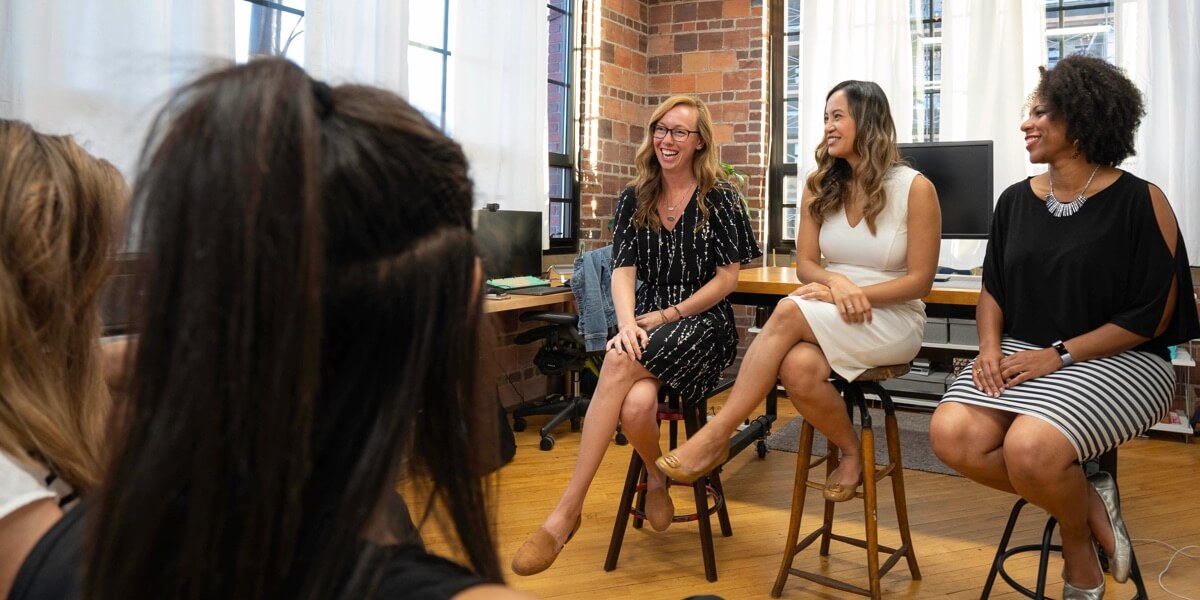The most successful organizations know that transparency makes their business stronger. And one of the ways they create that sense of trust and transparency with their teams is through all-hands meetings.
Company-wide, all-hands meetings bring together your team, give them a transparent view of what’s going on with your organization (both as a whole and within teams and departments), and get everyone involved in moving toward your goals. But not all all-hands meetings are created equal. If you want your all-hands meetings to be effective, and make sure that everyone in attendance walks away feeling included and excited about your organization and the direction you’re headed, there are a few best practices you’ll want to follow.
Why All-Hands Meetings Are Important
First things first: Before we jump into the practices you can leverage to increase the effectiveness and overall impact of your all-hands meetings, let’s quickly touch on why all-hands meetings are so important in the first place.
One of the biggest benefits of all-hands meetings is the intermingling both within teams and between employees and leadership, which can spark new connections and fresh ideas.
All-hands meetings drive “increased alignment between people who don't typically [work] together. This is a really good opportunity for people from various divisions to hear updates about what's going on within the company and to meet colleagues that they wouldn't necessarily work with on a day-to-day basis,” said Paula Cizek, Chief Research Officer at NOBL Collective, an organizational design firm that transforms company cultures. “You get intermingling and hopefully a cross-pollination of ideas and opportunities. And of course there's an opportunity to socialize and get to know your colleagues on a more personal level,” she said.
All-hands meetings also give your team a big-picture view of how their day-to-day tasks impact the organization as a whole, and how their work is benefiting both your company and their career growth.
“The goal of an all-hands meeting, ultimately, is two-fold,” said Cizek. “One, you want to give people an understanding of how their work is contributing to the bigger picture and to the company's goals. Then, the second part is how the company’s long-term goals and what they're working on is going to benefit their careers,” she said.
And, as a leader, if you can embrace transparency in your all-hands meetings and practice openness and honesty with your team, there’s also the added benefit of building trust. “If you can really demonstrate transparency and show that the leaders [of your organization] are more human...that's a real benefit of having an all-hands and bringing people together,” said Cizek.
Best Practices for All-Hands Meetings
Clearly, all-hands meetings can deliver a lot of benefits, both for your organization and your employees — but only if you do them well. Let’s dive into the must-know best practices for making your all-hands meetings as successful as possible.
1. Prep your team in advance.
If all-hands meetings aren’t a regular occurrence in your organization, make sure you don’t set off any alarm bells during the scheduling process.
“It's important to establish all-hands as neutral events,” said Cizek. “If anybody gets an email [in the current climate] which says ‘Hey everybody, we're doing an all-hands,’ people are immediately going to jump to a worst-case scenario,” she said.
When you’re sending out invitations to your first (or first in a long time) all-hands meeting, make sure to “include an agenda and let people know [what you’re going to be discussing]. Give them some [idea] of what to expect. Otherwise, they're just going to speculate,” she said.
By including an agenda and being transparent about the purpose of your all-hands meeting, you’ll put your team’s minds at ease — and ensure that they don’t start to panic that something negative (like a layoff) is on the horizon.
2. Keep your all-hands short and on time.
The more people you have in a meeting, the more challenging it is to keep them engaged. That’s why, if you want to make sure your all-hands meetings are effective and leave a lasting impression on your team, you’ll want to keep them short and to the point.
“Keep them brief,” said Kirk Guthrie, Executive Director of Human Resources at INNOCEAN USA, who has experience coordinating the advertising agency’s bi-weekly all-hands meetings for over 400 employees in their Huntington Beach, CA office and additional team members across the US and Canada. “They don't need to go on and on. You start to really lose participation and engagement [then],” he said.
Depending on how much ground you need to cover in your meeting, anywhere from 30 minutes to an hour should be plenty. And make sure that you start and end on time. You’ve asked your entire organization to step away from their day-to-day tasks to sit in on this meeting, and it’s important to show them that you respect their time.
“Make sure that you stay on time. Everybody has busy calendars...People have things to do, so be respectful of their time,” said Cizek.
3. Focus on the right content.
Again, you want to make sure that everyone in your all-hands meeting stays engaged and interested. And that means focusing on content that’s relevant and interesting to the entire company.
If you want to keep your all-hands meetings relevant to your whole organization, Guthrie suggests focusing on three key categories of content: critical information (which is especially important now, as companies navigate the coronavirus pandemic’s impact, including the shift to remote work) and present-day business, and then end with something fun, social, or interactive.
When it comes to present-day business, avoid getting too far into the weeds with your all-hands content. Ideally, your presentation or discussion should give a broad overview of what’s happening within your organization. Then, if employees want to learn more or get involved, they can follow up with the appropriate contact person or team directly.
“Keep it high-level enough where you can pique their interest, and then [let them] know who to follow up with,” said Guthrie.
And don’t forget the fun part. All-hands are an opportunity for your entire team to connect, learn more about each other, and socialize, so it’s imperative that you carve out the time and space for fun and connection at every all-hands meeting.
4. Switch things up.
All-hands meetings shouldn’t be an opportunity for your leadership to get up and talk at your team for an hour straight. While leadership input is important, if you want to keep things interesting and engaging, you’ll want to switch things up.
“[Your employees] don't want to hear from the same people every month,” said Guthrie. “Change up the presenters so the audience is excited about seeing new faces and learning more about [other teams] that maybe they don't get to work with every day,” he said.
For example, you could start your all-hands meeting with a welcome from your CEO. Then, after sharing any critical information with the team, leadership can pass the mic to another team for insights into what’s going on in their corner of the organization. Just make sure to pass the mic to a different team at each all-hands meeting.
“Rotate the cast of characters. You want to invite different people to participate to keep things fresh...It's great to be able to hear from different teams within the company, [and for] different divisions to be able to hear what's going on,” said Cizek.
5. Share both successes and opportunities.
When you ask a team to present at an all-hands meetings, chances are they’ll instinctively want to put their best foot forward. And that’s totally fine. All-hands meetings are a great place to share successes (and toot your own horn a bit). But with your entire company gathered in one place, it’s also an excellent forum for sharing learning opportunities.
“You should absolutely celebrate what your teams are doing and how far they've come, but it's just as important for people to hear what others [in the organization] have learned or what hasn't worked so well,” Cizek said.
When you ask a team to present at an all-hands meeting, give them the opportunity to share their successes. But, if possible, also ask them to share some of their challenges. And the same thing goes for the leadership team.
By letting other teams know challenges they’ve faced (and how they overcame them), those challenges transform from a learning opportunity for a single team or leader into one for your entire organization.
6. Make your meeting interactive with a live Q&A.
Again, having someone stand at the front of the room and talk at your entire organization for an hour isn’t the most engaging meeting format. If you want to keep your entire team engaged, invite participation and look for ways to make your all-hands meetings more interactive.
Obviously, the larger your organization, the more challenging it can be to allow everyone to participate. But hosting a Q&A with leadership can get your team involved in your all-hands meeting, no matter how many employees are in attendance.
Before you hold your meeting, ask your team to submit questions about leadership, your organization, or any other business-related items they might be curious about. Then, carve out a few minutes either at the beginning or the end of your all-hands meetings to address those questions.
“Open the floor to hold a Q&A or an AMA (ask me anything) session,” said Cizek. “We recommend that people submit questions in advance so that leaders can be prepared. You can set it up so questions are sent in anonymously so the people asking the questions also feel safe and…[you encourage] trust and transparency,” she said.
7. Make it inclusive for all employees.
When you’re hosting an all-hands meeting, it’s crucial that you make it inclusive for all employees — including those that aren’t attending in person.
As you’re planning your all-hands meeting, make sure you’re taking steps to include remote workers and make them an essential part of the meeting.
Cizek recommends taking the experience of the remote workers into account during your meeting-planning process. “If there's going to be a special presentation, make sure that you have the slides prepared in advance and send them to your remote workers...so that they can actually see what's going on,” she said.
You can also invite remote teams to present during your all-hands or encourage them to send questions through your video conferencing software — and then make sure to address those questions during the meeting.
Recording your all-hands can also be helpful. That way, if your remote team had trouble hearing or seeing a particular part of the meeting (or, for whatever reason, were unable to attend), they can get caught up with the replay.
8. Ask for feedback.
You want to make sure that your employees are getting something out of your all-hands meetings. One of the most important factors in running effective all-hands meetings, and ensuring that they continue to be effective, is getting feedback.
After your all-hands meetings, follow up with your team for feedback. Ask them what they enjoyed about the meeting, what they thought could be improved, and what they’d like to see changed for the next all-hands. Then — and this is the crucial part — make sure to take the time to read through that feedback and use it to drive the planning and execution of your next all-hands.
When you take your employees’ feedback and use it to improve and evolve your all-hands meetings, not only do your meetings become more effective and impactful, but your team also feels respected and heard, which can lead to better employee engagement.
Now that you know how to make all-hands meetings more successful, all that’s left to do is get all hands on deck and start planning your next company-wide meeting.







